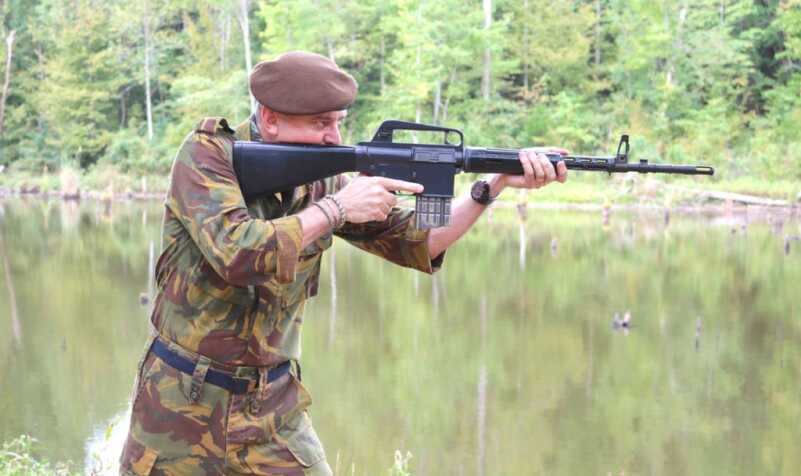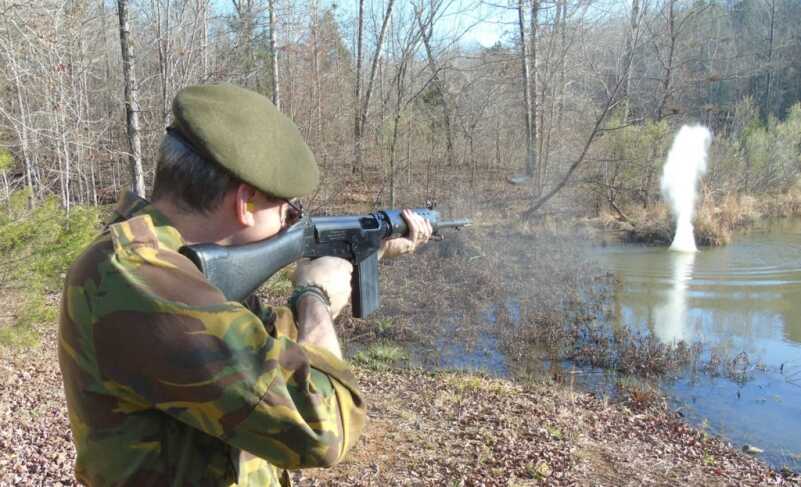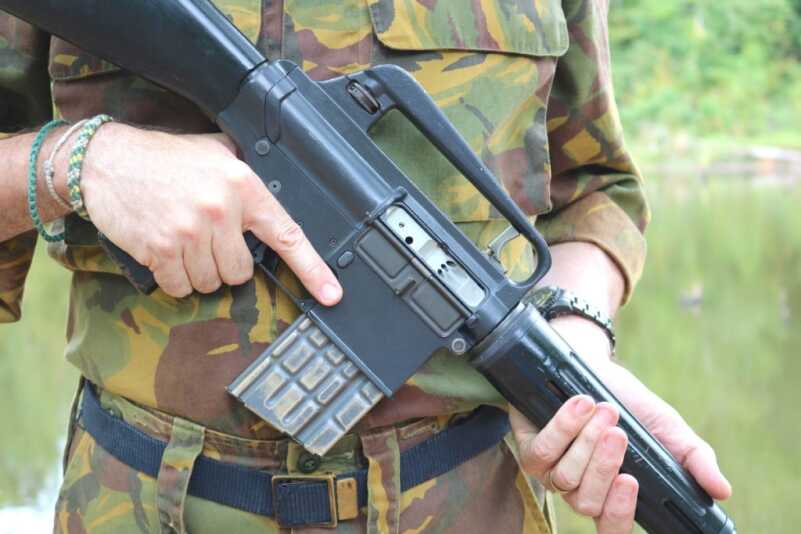Much of the accepted vernacular we use in this quirky little hobby of ours arose from common usage. The term Assault Rifle, as an example, was likely coined by Adolf Hitler. Rumor has it that the original MP43 was titled a Machine Pistol in an effort at circumventing der Fuhrer’s prohibition against rifles that fired anything but full-size 7.92x57mm rounds. When the alpha lunatic was formally introduced to this revolutionary selective fire rifle he purportedly rejoiced and christened it the “Sturmgewehr” or “Storm Gun” on the spot. Some unknown intelligence officer supposedly mistranslated the term into Assault Rifle, and the rest is history. Modern Leftists have subsequently twisted the moniker to encompass any firearm that makes your heart race a bit when you gaze upon it. The term Battle Rifle has comparably pedestrian origins.
The Battle Rifle is commonly accepted to be an autoloading combat rifle that feeds from a detachable magazine and fires a full-sized .30-caliber round. While Battle Rifles found their stride in the years following the Second World War, they have been largely replaced by small caliber Assault Rifles nowadays. However, combat in such places as Afghanistan has shown us in recent years that the need still exists for a man-portable .30-caliber rifle that can offer precision fires out past the range of the 5.56mm cartridge. While the current popular term for these weapons when equipped with telescopic sights is Designated Marksman Rifles, it behooves us to review the fertile soil from whence they arose. To do so we need to wind the clock back to the 1950’s.
Origin Story
The United States had just armed and equipped the Allies to win World War 2, the most expansive conflict in all of human history. This global hemoclysm killed off 3% of the world’s population and provided the catalyst to advance the state of the art in modern weaponry exponentially. Combat aircraft, submarines, tanks, and small arms all underwent a quantum advance during the six years that most of the major combat occurred. With this vast fount of combat experience from which to draw, American military planners organized a formal competition to select the Infantry rifle that would replace the M1 Garand.
The Garand was an undeniably effective combat weapon, but it was flawed from the outset. 44 inches long and weighing the better part of ten pounds, the M1 fed from an 8-round en bloc clip that served as an integral part of the weapon’s action when in use. On the last round fired the spring steel clip was forcibly ejected from the rifle and the bolt remained to the rear. A fresh clip could then be inserted from the top to recharge the gun. By the 1950’s we could do better.
The Trials
Conducted over several years, the Infantry Board Service Rifle Trials had as their goal to select a modernized replacement for the M1 Garand under the auspices of the “Lightweight Rifle Program.” The trials involved a strict selection process that strived to emulate the various environmental rigors under which a modern American service rifle might be expected to prevail. While the details are arcane and tedious, the competition eventually boiled down to three contenders, only two of which were taken seriously. All three guns fired the new 7.62x51mm round.
Based upon the existing .300 Savage cartridge, the 7.62x51mm was christened commercially as the .308 Winchester. The use of modern ball powders developed by the Olin Corporation allowed designers to use a case fully 12mm shorter than the older .30-06/7.62x63mm round yet still produce comparable downrange performance. With this new round as a basis all the Lightweight Rifle contenders were chambered to fire it.

From left to right are the 7.62x39mm M43 Combloc, the 7.62x51mm NATO, and the 5.56x45mm NATO rounds.
The T44 was the earliest version of what went on to become the M14. Essentially a product-improved M1 Garand, the T44 featured a detachable 20-round box magazine, a shortened receiver, an abbreviated gas piston system, and selective fire capability. The T44 was a product of the government’s Springfield Armory.
The T48 was a domestically produced version of the Belgian FN FAL. The FN FAL was a thoroughly modern design that arose from the ashes of World War 2. Originally chambered for the German 7.92x33mm Kurz round, the FN FAL was a product of the esteemed Belgian gun designers Dieudonne Saive and Ernest Vervier. The FN FAL was ultimately rechambered for the 7.62x51mm round for the trials. The Belgians gifted the rights to the FAL’s production to the Western Allies in appreciation for their liberation during World War 2. The assumption at the time was that the FAL along with its 7.62x51mm cartridge would be adopted as the standard combat rifle across NATO.
The AR10 was a radically advanced weapon that was the product of the ArmaLite Corporation, a small subsidiary of the Fairchild Aircraft Company. Incorporating cutting-edge material science drawn from the modern American aviation industry, the AR10 represented a revolutionary development in small arms. At the time of the trials the particulars of the AR10 were still being ironed out so most of the samples used for competition were hand-built tool room guns.
The stipulations demanded of the program were that the rifle fire the new 7.62x51mm round, that it be fed from a 20-round detachable box magazine, and that the gun weighs seven pounds loaded. The weight stipulation was eventually adjusted to 7 pounds unloaded and then ignored altogether. In the final analysis, the AR10 came in just shy of the limit at 6.85 pounds, while the T44 was 8.45 pounds and the T48/FAL was 9.47.
Our Contestants
Our stand-in for the T44 is a pre-ban Springfield Armory M1A. A semiauto version of the GI-issue M14, this rifle sports a gorgeous American walnut glass-bedded stock and National Match sights. The stripper clip guide has been replaced with a secondary scope mount attachment point. For all practical purposes, this M1A is the semiauto equivalent of that original T44.

This Springfield Armory M1A stands in for the original T44 for our version of the 1950’s Infantry Board Lightweight Rifle Trials. Rugged, accurate, and objectively pretty, the M14 is a rifleman’s rifle.
Our T48 clone is a semiauto gun built up using a British SLR parts kit on a domestic receiver. This rifle sports a few amenities like a folding charging handle and synthetic stocks but is morphologically similar to that original T48. As this rifle was produced during the 1994 Assault Weapons ban it has had the threaded portion of its muzzle excised. An original SLR flash suppressor has subsequently been slip fit and pinned in place. While the muzzle was professionally crowned this does mean that the barrel is perhaps half an inch shorter than that of the originals.

This British SLR parts gun represents the T48 FAL. Heavy long, and elegant, the T48 was a relatively new design at the time of the Infantry Board trials.
Our AR10 began life as a Dutch rifle produced for use by Portuguese Special Forces in the various brushfire wars they fought in Africa in the 1960’s. This gun was used operationally before being dismantled and imported into the United States sans receiver as a demilled parts kit. These components were then resurrected upon a domestically produced semiauto AR10 chassis. Despite its high mileage history, this AR10 is in surprisingly good shape with minimal wear on the reciprocating parts and plenty of life left in the barrel.

This Dutch AR10 was used by Portuguese Special Forces before being demilled and imported into this country. Resurrected on a domestically produced receiver, this has got to be the most expensive bodged-together parts gun on the market today.
Practical Impressions
The M1A is bulky and heavy but remains an imminently functional combat tool. Magazines must be rocked in place, but this allows easy seating of a full mag with the bolt closed. The safety is stiff but easily accessible regardless of your handedness. The exposed nature of the charging handle allows the shooter to take a boot to it if the action gets sticky. The bolt locks to the rear after the last round is fired. To close the bolt over a fresh magazine one simply gives the charging handle a quick snatch to the rear. The gun is easily maintained and robust, though it always takes a bit of body English to get the bolt and op rod seated for reassembly. The bolt incorporates a splendid roller bearing that keeps its operational cycle smooth.

The M1A is, in essence, a product-improved M14 without the selector switch. The basic morphology is the same between the two guns.

The op rod on the M1A transfers energy from the gas piston back to the bolt. This component on the M1 Garand was very similar.
The FAL is an exceptionally comfortable design that is easy to run. Magazines must also be rocked into place, and the fire selector is easily accessed so long as you are right-handed. Left-handed people are just screwed, but they should be used to that by now. The gas system is easily adjustable for varying degrees of filth, and the rifle is more easily stripped and maintained than the other two contenders. The FAL is front heavy and tedious to hump, but our forebears had it worse. Those old guys who won World War 2 were harder and better than are we today. The FAL is generally extolled as the ideal example of the Battle Rifle genre, and I cannot dispute that characterization.

The charging handle on this SLR folds flush when not in use. The same appendage on the FAL did not fold.

The ergonomics on the FAL are superb. This combat rifle equipped military and LE units in more than 90 countries.
The AR10 exhibits the seeds of the brilliance that ultimately made the M16 so successful. The gun just feels right in the hands, and everything is where it needs to be for easy access and quick manipulation. The charging appendage in the carrying handle does not reciprocate with the bolt and is easy to operate with either hand. This component demands a sliding sheet metal bit to keep the slot free from battlefield grunge, but may yet be an improvement over the T-shaped charging handle we use on our M4’s today. The magazine release and bolt catch are handy and intuitive.

The trigger-shaped charging appendage in the carrying handle is simple to use, effective, and easily accessed with either hand.

The AR10’s muzzle attachment is internally threaded for a blank adapter. The bayonet lug mounts the bayonet above the barrel.

The AR10’s direct gas impingement brings more fouling into the receiver than competing gas piston designs yet remains accurate and reliable with proper maintenance.

Those early AR10 rifles were wildly popular with the troops that used them. Reliable and lightweight, these guns ushered in a new era in small arms.
All three of these rifles shoot straight. The AR10 is theoretically the most accurate, while the FAL is likely the most reliable. However, this is hair-splitting. All three rifles easily render fine combat accuracy on the range that exceeds the innate capacity of my high-mileage eyes. They are also all three proven and mature designs that will function reliably under adverse conditions.

From left to right are magazines for the T48, the AR10, and the T44. All three guns run the same 7.62x51mm rounds.
And the Winner is….
Back in 1956 an experimental composite barrel failed spectacularly on the AR10 after some 5,000 rounds and doomed the rifle. Had its designers and marketers not tried to push the design quite so hard it might yet have prevailed. The ergonomics of the weapon were thoroughly vindicated through the meteoric trajectory of the M16, now the longest-serving combat rifle in American history.
The final sudden death round came down to an arctic assessment between the T44 and T48. The T44 was the hometown favorite, and the folks at Springfield Armory took full advantage, tweaking the design to optimize it for service in the harsh arctic wastes. By contrast, the T48 was thrown into this phase unprepared. In desperation, the accompanying engineers opened up the gas ports on the rifles to provide the added horsepower they might need to overcome the ice, and the guns beat themselves to death. This fact combined with the T44’s one-pound weight advantage ensured its victory.
With the benefit of hindsight, the T48 was likely the better rifle. The FAL went on to serve as the primary weapon for some ninety different nations and rendered fine service in the most arduous environments in the world. By contrast, the M14 only held the title of US Army service rifle for perhaps half a dozen years before being supplanted by the small-caliber M16. The AR10 was and is a superb design, but it needed some tweaking before it could hold its own with the likes of the T44 and T48.
In the final analysis, none of that mattered. Vietnam changed the way we viewed combat rifles, and the entire planet followed our lead. Nowadays everybody issues small-caliber, high-velocity weapons, and the larger-caliber guns are sprinkled about as needed if the threat remains a long ways off. However, had things been just a little bit different we might have entered the Vietnam War armed with FALs rather than M14’s. It is also not beyond the realm of consideration that the AR10 could have taken the day and given us a Stoner gun even earlier than 1966. Such stuff is thought provoking indeed.

The 7.62x51mm round is remarkably powerful for its size. As can be seen from this shot into water with a safe backstop, the bullet packs plenty of horsepower.
Vital Statistics
T44 T48 AR10
Caliber 7.62×51 NATO 7.62×51 NATO 7.62×51 NATO
Barrel Length 22 in 21 in 20.8 in
Overall Length 44.25 in 44.63 in 41.25 in
Weight 8.45 lbs 9.47 lbs 6.85 lbs
Stock Material Wood Wood Polymer
Action Gas Piston Gas Piston Gas Impingement
Operation Selective Fire Selective Fire Selective Fire












I happen to love the ’14. Great shooter, comfortable to shoot and much, much more shooter comfortable to shoot and carry than any FNFAL that I have ever handled. And shooting is really the only thing that matters with a combat weapon. That said I have long since changed all that thinking to love the AR 10 especially in the AR-308 version. Shoots even more accurate than my esteemed 14 in the clothes of a Super match M1A, which I would have thought impossible until I started playing with the AR. AND I can switch calibers all over the place. Heck, I think I have six or eight 🙂 different calibers and configurations ranging from 243, 6MM Remington, 6.5 Creed, 7MM-08, and of course 7.62. AND in versions from 12 inch barrel (pistol) to 24 inch heavy. ALL super accurate and super dependable. The FAL is a curiosity I keep in my gun room, not a good choice for a “Battle Rifle” no matter what the “Foreign” has to be cool and better group. The M1A’s I have the National Match equipped lighter rifle as well as the Super Match are still great guns, BUT simply not as good of a “Battle Rifle” as a light weight barreled AR. The only improvement over that would be to have it on a side cocking upper version, or multi-cocking version. So from someone who loved a M-14 and absolutely HATED the AR-s they switched in a tropical vacation our good Uncle sent us on (and that completely biased me for twenty years) I have become a fanatic about the AR’s. Can they be improved? Sure and ARE in almost every possible way someone wants. And that serviceability, and shoot-ability make them better than my M1-A or my old 14 was. AND so far above a FAL to even be considered. And any fool can assemble one (proven by me assembling all of mine) to their exact desire or need.
“Imminently” != “eminently.” Please don’t expect spell-checkers to catch malapropisms; use the right word, & if you don’t know it, use a different one you *do* know. Write on!
Mike, who really gives a damn while reading it. This is a conversation about guns, not English Lit 101. A publisher once told me that people with Masters in English were dime a dozen for “copywriters”, but good story tellers are hard to find. So much for spell checking and grammar. 🙂
Another great article. Probably new info to some, refresher for me. Well written and photographed.
Use M-14 for two years in Vietnam Love to Have one Back…Life Saver…Amen…173rd lnf…
Not a Viet Nam Vet, though a former 0331, I am reading a book called “Dead Center”…a Marine Sniper’s experience in Viet Nam – circa 66′-68′.
While equipped w/a bolt action Winchester, the Author also carried a “14” every time they were on the hostile side of the wire…there’s a passage in the book wherein he recounts his first experience with the M-16. While out “snooping & pooping” with a Company sized force (they were equipped with shiny new M-16 rifles) they were ambushed…the after action report showed multiple Grunt casualties who had their M-16s broken down trying to clear jams and other issues.
Semper Fi and thanks for your Service…